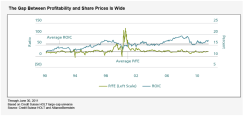This blog is part of a new series on Institutional Investor entitled Global Market Thought Leaders, a platform that provides analysis, commentary, and insight into the global markets and economy from the researchers and risk takers at premier financial institutions. Our first contributor in this new section of Institutionalinvestor.com is AllianceBernstein, who will be providing analysis and insight into equities.
We’ve all been taught to take the tangible bird in hand over the elusive two in the bush. But it seems that today’s stock investors have faith in neither.
The pessimism priced into the US stock market can be seen in the portion of the S&P 500 aggregate index value assigned to future growth. This quantitatively sophisticated but conceptually simple measure, calculated by Morgan Stanley, starts with the “tangible” portion of the index’s value: the present value of index constituents’ current earnings per share. Subtract that amount from the index value, and the remainder you get reflects the expectation for future earnings growth that is priced into the stocks. This percentage can vary widely, but has averaged about one-third of the stock price over time.
Recent readings, however, have been negative, a phenomenon we haven’t seen since the high-inflation days of the late 1970s and early 1980s. Investors seem to believe that company earnings will actually contract, on balance, for the foreseeable future. Even if we argue that earnings growth is near historical peaks and likely to slow, broad-based drops in overall corporate earnings are rare, and when they occur—as in the recent deep recession—they tend to be brief. Yet market pricing today suggests that investors expect earnings to drop like a rock—and, like a rock, to not bounce back again.
There are certainly grounds for skepticism about the sustainability of robust corporate earnings growth, given economic sluggishness and weakness in consumer spending and housing. But demand for US exports from emerging markets, and the need for many companies to reinstate deferred capital spending as equipment ages, will give the economic expansion legs, in our view.
Companies are also becoming more efficient at investing capital in profitable activities, which positions them to redeploy today’s historically high cash flows into greater profit-generating capability down the road. Return on invested capital, a standard measure of profitability, now stands well above its historical average for the broad universe of US large-cap growth stocks (see display below). Nonetheless, the price-to-forward-earnings ratio for the same universe is just average.
Such pricing anomalies for individual stocks are widespread. Fragile sentiment has prompted investors to price what we view as too much risk into many stocks, even reliable generators of earnings growth such as Google and Apple. The price to forward earnings of both (and many other companies) has declined as their return on invested capital has risen.
Granted, these stocks raise reasonable concerns. With Google, it’s whether online advertising is peaking. I’d say evidence suggests that online is significantly underrepresented in current ad spending and that Google has the mobile search segment—which is likely to be the primary source of advertising growth over the next few years—virtually to itself. Yet the price of the stock implies that the average sales growth rate over the next five years will drop by approximately 80% from its average over the previous eight years.
Similarly, the controversy about Apple is whether it will lose market share in categories that it helped establish, such as smartphones and tablet computing. Even if it does, the categories themselves should grow, providing Apple with considerable upside opportunity. The company has expanded sales by at least 25% every year since 1993—including 2008, during the deepest recession in recent memory. Yet the recent stock price implies that the company will not break that threshold in any of the next five years.
Even if such anomalies reflect just a very short-term horizon, individual companies’ consistent above-consensus earnings growth would suggest that investors are still underestimating in some cases. In my view, today’s risk-averse environment has created an unusual number of mismatches between share price and earnings-growth potential that investors can exploit.
Scott Wallace is the Team Leader—US Large Cap Growth at AllianceBernstein
The views expressed herein do not constitute reseach, investment advice or trad recommendations and do not necessarily represent the views of all AllianceBernstein portfolio managment teams.







